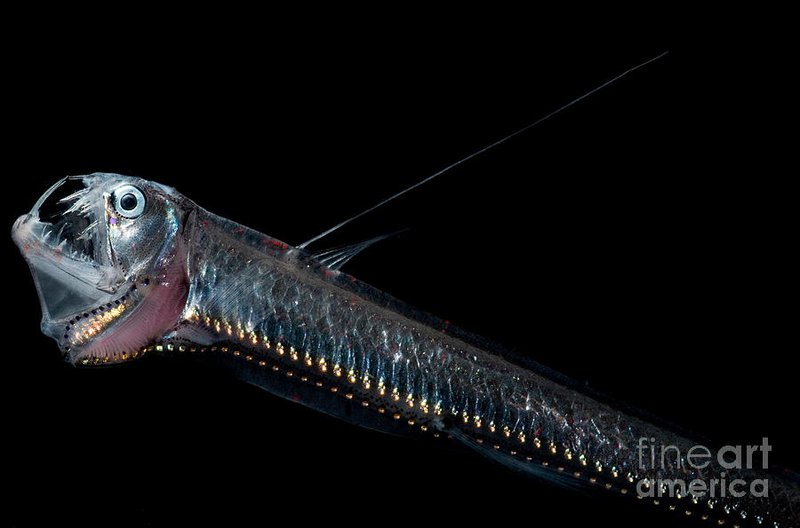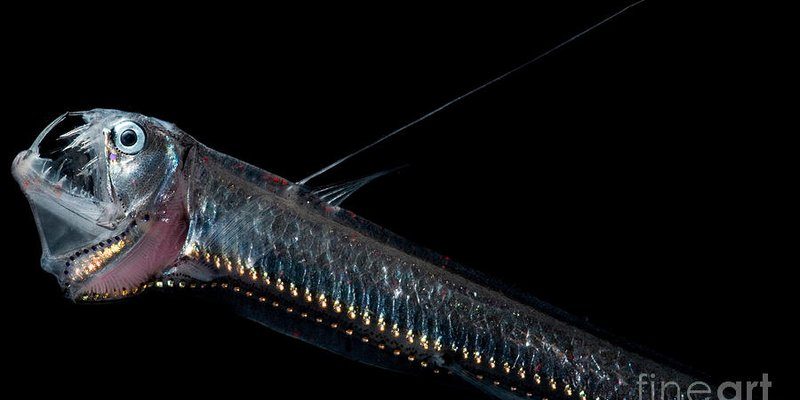
Imagine diving deep into the ocean where sunlight barely reaches, and you stumble upon a creature that looks like it belongs in a sci-fi movie. That’s the viperfish for you! With its elongated, slender body and ferocious teeth, this fascinating fish is a true marvel of the deep sea. It inhabits the darker depths of the ocean, where it has adapted uniquely to survive in a world where light is a rare commodity.
The viperfish is not just a predator; it’s a master of its environment. Its extreme adaptations enable it to thrive in conditions that would be daunting for many marine creatures. From its bioluminescent lure to its impressive jaw, the viperfish has evolved into a highly effective hunter. Let’s dive deeper into what makes this fish so unique and captivating.
Physical Characteristics
The viperfish boasts an array of physical traits that make it remarkable. Typically, these creatures can grow to about 12 inches long, although some individuals have been reported to reach lengths of up to 18 inches. Its body is long and narrow, allowing it to navigate through the ocean’s depths with ease. One of the most striking features of the viperfish is its large, fang-like teeth, which can be quite intimidating. These teeth are perfect for grabbing prey, as they prevent any chance of escape.
Another fascinating aspect of the viperfish’s anatomy is its ability to produce light. It has photophores—small light-producing organs—along its body. This bioluminescence serves multiple purposes, such as attracting prey in the dark waters and confusing predators. Just picture it: a glowing silhouette moving through the pitch-black ocean, luring smaller fish into its jaws. It’s nature’s version of a glittering trap!
Habitat and Distribution
Viperfish predominantly inhabit the deep ocean, typically found at depths ranging from 200 to 2,000 meters, where the pressure is immense and sunlight is non-existent. They thrive in the mesopelagic and bathypelagic zones—these are the layers of the ocean where light starts to fade away. This habitat is not just a home; it’s a survival zone where they can avoid many predators that lurk above.
Geographically, viperfish are widespread, found in both the Atlantic and Pacific Oceans. They prefer deep, open waters but can sometimes be spotted close to the surface during the night, as they rise to hunt. This nocturnal behavior is fascinating since it allows them to exploit the darkness to their advantage, hunting during times when visibility is low for both them and their prey.
Diet and Hunting Techniques
The viperfish is primarily carnivorous, with a diet that consists mainly of smaller fish and squid. Using its bioluminescent lure, the viperfish attracts curious prey, drawing them closer before striking with incredible speed. Their hunting skills are nothing short of impressive; they can open their jaws wide enough to swallow prey almost half their size!
When hunting, the viperfish combines its unique appearance with its strategic ambush techniques. It often lies in wait while camouflaged against the dark background of the ocean. Once an unsuspecting fish swims by, it darts out with lightning speed. It’s this combination of patience and power that makes the viperfish a top predator in its environment.
Reproduction and Lifespan
Reproduction among viperfish is still not fully understood, primarily due to the difficulties of studying them in their deep-sea habitats. However, it’s believed that viperfish engage in a form of spawning. Females are thought to release their eggs into the water column, where males then fertilize them externally. This process may occur in deeper waters to protect the vulnerable larvae from predators.
As for their lifespan, viperfish are known to live for about 20 years in the wild. While this may not seem exceptionally long in the grand scheme of life, it allows them enough time to mature and reproduce. The longevity of the viperfish is an advantage in the harsh and competitive environment of the deep ocean.
Adaptations to Deep Sea Life
Viperfish have made some incredible adaptations to survive at such depths. One major adaptation is their lack of a swim bladder, a gas-filled organ that many fish use to maintain buoyancy. Instead, viperfish rely on their unique body structure and muscular tail for movement. This allows them to navigate the deep ocean without the risk of being crushed by pressure.
Moreover, their large eyes are adapted to low-light conditions, enabling them to see in the dark, murky waters of the deep sea. These adaptations ensure that they can not only survive but also thrive in an environment that’s challenging for most other marine life. Isn’t it amazing how nature finds a way?
Conservation Status
Currently, viperfish are not considered threatened or endangered. Their populations appear stable, primarily due to their deep-sea habitat, which is less affected by human activities compared to shallower waters. However, like many marine species, they could be impacted by climate change and oceanic shifts.
As ocean temperatures rise and ecosystems change, the viperfish’s habitat may be affected. While they are currently thriving, ongoing monitoring and research are essential to ensure that their populations remain healthy. Protecting our oceans is crucial not just for viperfish but for all marine life that depends on these ecosystems.
Interesting Facts about Viperfish
| Size: | Typically up to 12 inches, with some reaching 18 inches. |
| Habitat: | Found at depths of 200 to 2,000 meters in the Atlantic and Pacific Oceans. |
| Diet: | Carnivorous, primarily eats small fish and squid. |
| Lifespan: | About 20 years. |
| Unique Trait: | Produces bioluminescent light to attract prey. |
FAQ
What do viperfish look like?
Viperfish have an elongated, slender body that typically ranges from 12 to 18 inches in length. Their mouths are very large, equipped with long, fang-like teeth that make them appear quite menacing. Their bodies are often silvery with a dark, almost transparent quality, which helps them camouflage in the deep water. Their trademark feature is the glowing photophores that line their body, giving them a unique glow in the dark depths of the ocean.
How do viperfish catch their prey?
Viperfish utilize their bioluminescent lure to attract smaller fish and squid. They lie in wait, blending into the darkness, and when a curious fish approaches their light, they strike quickly using their large mouths to capture the prey with their sharp teeth. This ambush technique allows them to be effective hunters even in the depths of the ocean where visibility is low.
Are viperfish dangerous to humans?
While viperfish are fierce predators in their environment, they pose no danger to humans. They inhabit deep ocean waters, far from where most people swim or dive. Their large teeth are designed for catching their prey rather than attacking larger animals, and they are generally not aggressive towards humans. So, if you’re exploring the ocean, you can rest easy knowing viperfish are far beneath you!
How do viperfish survive in the deep ocean?
Viperfish have adapted in several remarkable ways to survive in the harsh conditions of the deep ocean. They lack a swim bladder, which allows them to withstand the immense pressure. Their large, sensitive eyes help them see in the dark, and their bioluminescent bodies allow them to attract prey. Additionally, their unique hunting strategies make them efficient predators even in the abyss where food can be scarce.
Where can I find viperfish?
Viperfish are found in the deep waters of both the Atlantic and Pacific Oceans. They generally inhabit depths ranging from 200 to 2,000 meters, often residing within the mesopelagic and bathypelagic zones. If you’re interested in spotting one, you’d need to explore these dark depths, perhaps by deep-sea diving or scientific submarine expeditions, as they are not found in shallower, well-lit waters.
What role do viperfish play in their ecosystem?
Viperfish play a crucial role as both predator and prey in deep-sea ecosystems. As predators, they help keep the populations of their prey species—like smaller fish and squid—in check, contributing to the ecological balance. Additionally, they serve as prey for larger deep-sea predators, which helps sustain the food web in their environment. Every creature has its part in maintaining the health of ocean ecosystems, and the viperfish is no exception.
Can viperfish see in the dark?
Yes, viperfish have large, well-developed eyes that enable them to see in extremely low-light conditions. Their eyes can detect even the faintest bits of light, allowing them to hunt effectively in the dark waters where they live. This adaptation is essential for their survival in the deep ocean, where the absence of natural light makes visibility a big challenge.
Do viperfish have any predators?
While viperfish are apex predators in their habitat, they are not without their own threats. Larger fish and other deep-sea predators may hunt them. Additionally, many young viperfish may fall victim to various marine creatures while they are still small and more vulnerable. The harsh reality of the deep-sea ecosystem means that survival is a constant struggle for everyone, including the viperfish.
What is the lifespan of a viperfish?
Viperfish can live for about 20 years in the wild. While that may not seem as long as some other marine species, it allows them enough time to grow, mature, and reproduce. Understanding their lifespan is crucial for conservation efforts since prolonged environmental changes can impact their populations over time.
Are viperfish social or solitary creatures?
Viperfish are generally solitary creatures. They tend to roam the deep sea alone, hunting for food and avoiding predators. While they may occasionally come across others of their kind, they do not exhibit social behavior like some species of fish do. Their solitary nature is likely an adaptation to their deep-sea environment, where resources can be sparse.
Why are viperfish significant in scientific research?
Viperfish are significant in scientific research primarily because they can provide insights into deep-sea ecosystems and the adaptations of marine life to extreme environments. Studying their bioluminescence and feeding strategies helps scientists understand more about living organisms in dark environments. Additionally, they can serve as indicators of ocean health, making them an important species in marine biology.

